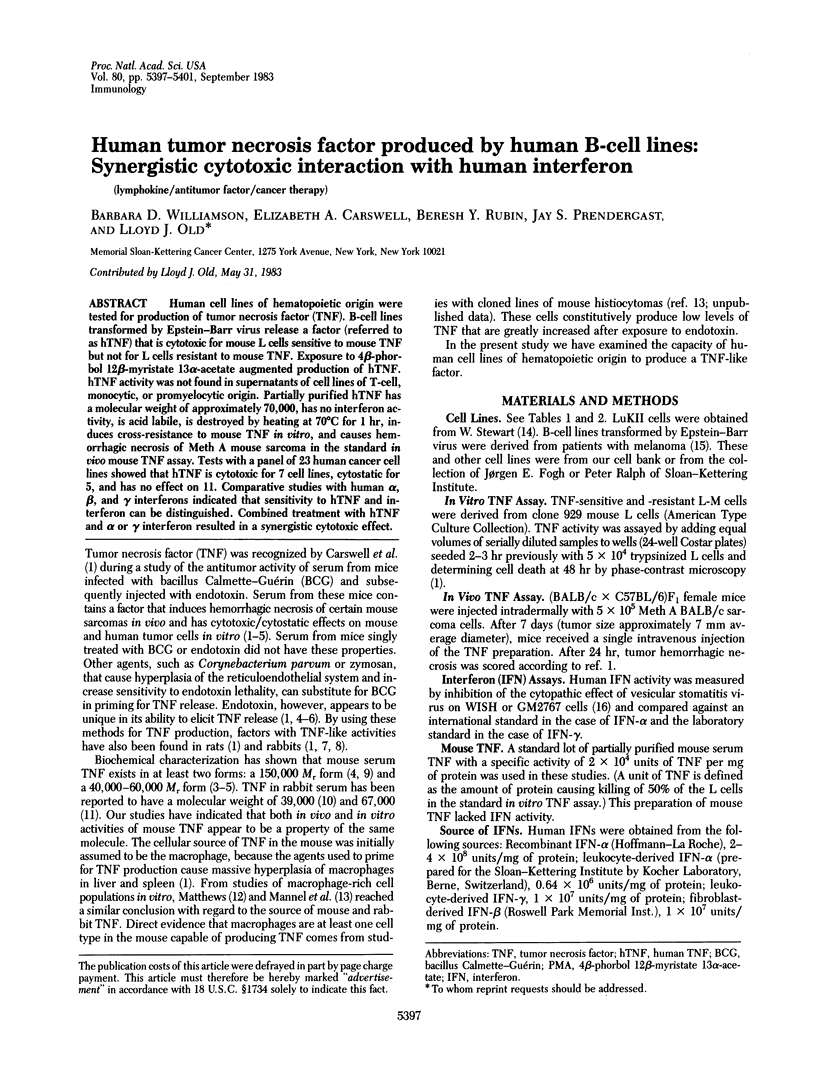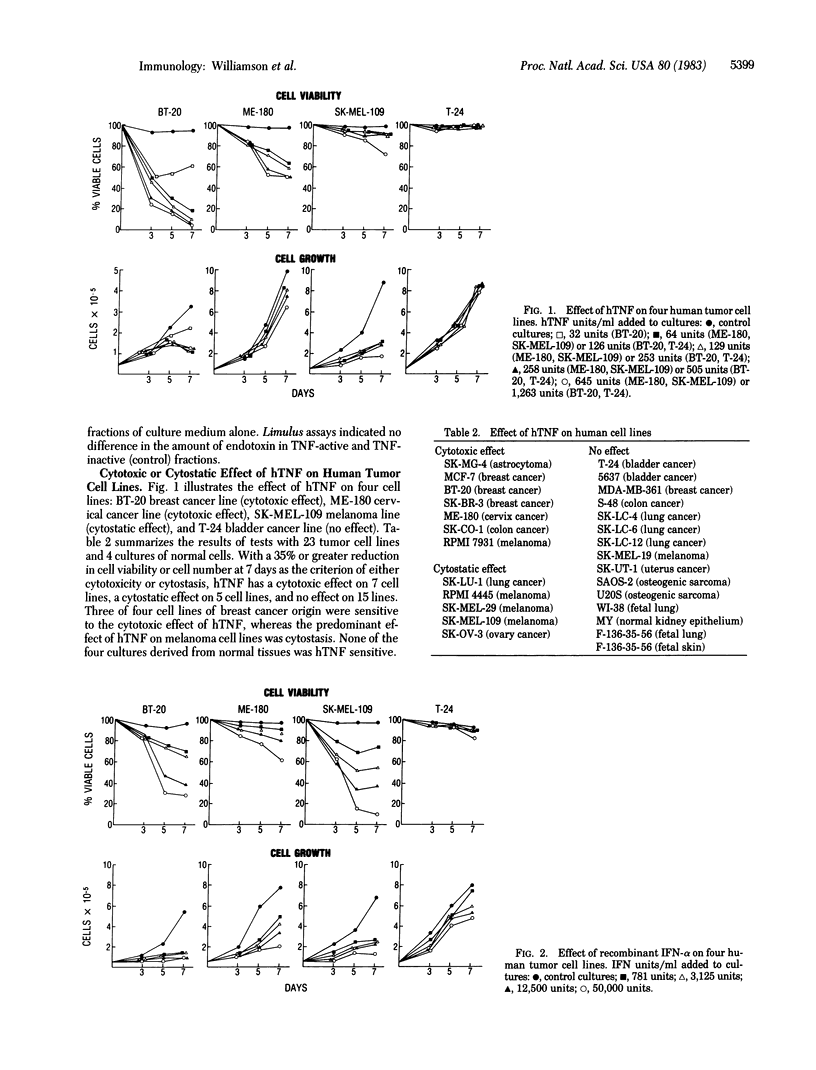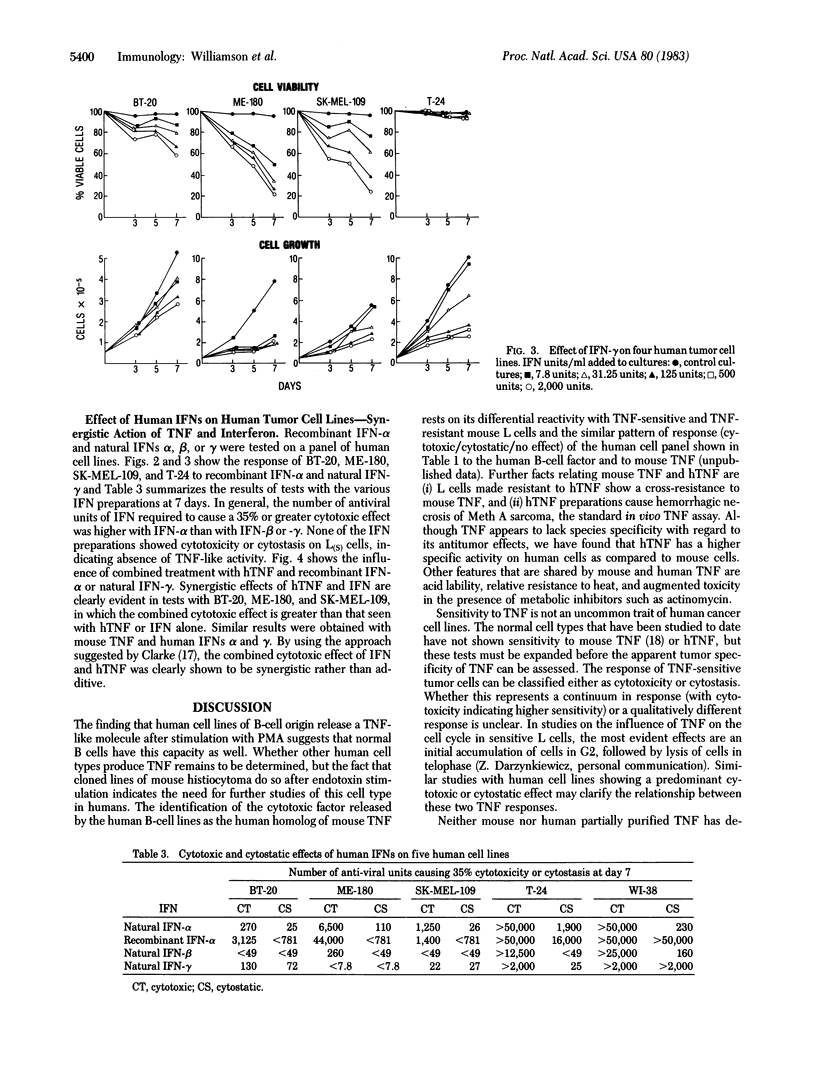Abstract
Human cell lines of hematopoietic origin were tested for production of tumor necrosis factor (TNF). B-cell lines transformed by Epstein-Barr virus release a factor (referred to as hTNF) that is cytotoxic for mouse L cells sensitive to mouse TNF but not for L cells resistant to mouse TNF. Exposure to 4 beta-phorbol 12 beta-myristate 13 alpha-acetate augmented production of hTNF. hTNF activity was not found in supernatants of cell lines of T-cell, monocytic, or promyelocytic origin. Partially purified hTNF has a molecular weight of approximately 70,000, has no interferon activity, is acid labile, is destroyed by heating at 70 degrees C for 1 hr, induces cross-resistance to mouse TNF in vitro, and causes hemorrhagic necrosis of Meth A mouse sarcoma in the standard in vivo mouse TNF assay. Tests with a panel of 23 human cancer cell lines showed that hTNF is cytotoxic for 7 cell lines, cytostatic for 5, and has no effect on 11. Comparative studies with human alpha, beta, and gamma interferons indicated that sensitivity to hTNF and interferon can be distinguished. Combined treatment with hTNF and alpha or gamma interferon resulted in a synergistic cytotoxic effect.
Full text
PDF




Selected References
These references are in PubMed. This may not be the complete list of references from this article.
- Blalock J. E., Georgiades J. A., Langford M. P., Johnson H. M. Purified human immune interferon has more potent anticellular activity than fibroblast or leukocyte interferon. Cell Immunol. 1980 Feb;49(2):390–394. doi: 10.1016/0008-8749(80)90041-6. [DOI] [PubMed] [Google Scholar]
- Borden E. C., Hogan T. F., Voelkel J. G. Comparative antiproliferative activity in vitro of natural interferons alpha and beta for diploid and transformed human cells. Cancer Res. 1982 Dec;42(12):4948–4953. [PubMed] [Google Scholar]
- Carswell E. A., Old L. J., Kassel R. L., Green S., Fiore N., Williamson B. An endotoxin-induced serum factor that causes necrosis of tumors. Proc Natl Acad Sci U S A. 1975 Sep;72(9):3666–3670. doi: 10.1073/pnas.72.9.3666. [DOI] [PMC free article] [PubMed] [Google Scholar]
- Granger G. A., Yamamoto R. S., Fair D. S., Hiserodt J. C. The human LT system. I. Physical-chemical heterogeneity of LT molecules released by mitogen activated human lymphocytes in vitro. Cell Immunol. 1978 Jul;38(2):388–402. doi: 10.1016/0008-8749(78)90069-2. [DOI] [PubMed] [Google Scholar]
- Green S., Dobrjansky A., Carswell E. A., Kassel R. L., Old L. J., Fiore N., Schwartz M. K. Partial purification of a serum factor that causes necrosis of tumors. Proc Natl Acad Sci U S A. 1976 Feb;73(2):381–385. doi: 10.1073/pnas.73.2.381. [DOI] [PMC free article] [PubMed] [Google Scholar]
- Green S., Dobrjansky A., Chiasson M. A., Carswell E., Schwartz M. K., Old L. J. Corynebacterium parvum as the priming agent in the production of tumor necrosis factor in the mouse. J Natl Cancer Inst. 1977 Nov;59(5):1519–1522. doi: 10.1093/jnci/59.5.1519. [DOI] [PubMed] [Google Scholar]
- Haranaka K., Satomi N. Cytotoxic activity of tumor necrosis factor (TNF) on human cancer cells in vitro. Jpn J Exp Med. 1981 Jun;51(3):191–194. [PubMed] [Google Scholar]
- Helson L., Green S., Carswell E., Old L. J. Effect of tumour necrosis factor on cultured human melanoma cells. Nature. 1975 Dec 25;258(5537):731–732. doi: 10.1038/258731a0. [DOI] [PubMed] [Google Scholar]
- Houghton A. N., Taormina M. C., Ikeda H., Watanabe T., Oettgen H. F., Old L. J. Serological survey of normal humans for natural antibody to cell surface antigens of melanoma. Proc Natl Acad Sci U S A. 1980 Jul;77(7):4260–4264. doi: 10.1073/pnas.77.7.4260. [DOI] [PMC free article] [PubMed] [Google Scholar]
- Kull F. C., Jr, Cuatrecasas P. Preliminary characterization of the tumor cell cytotoxin in tumor necrosis serum. J Immunol. 1981 Apr;126(4):1279–1283. [PubMed] [Google Scholar]
- Matthews N., Ryley H. C., Neale M. L. Tumour-necrosis factor from the rabbit. IV. Purification and chemical characterization. Br J Cancer. 1980 Sep;42(3):416–422. doi: 10.1038/bjc.1980.253. [DOI] [PMC free article] [PubMed] [Google Scholar]
- Matthews N. Tumour-necrosis factor from the rabbit. II. Production by monocytes. Br J Cancer. 1978 Aug;38(2):310–315. doi: 10.1038/bjc.1978.203. [DOI] [PMC free article] [PubMed] [Google Scholar]
- Matthews N., Watkins J. F. Tumour-necrosis factor from the rabbit. I. Mode of action, specificity and physicochemical properties. Br J Cancer. 1978 Aug;38(2):302–309. doi: 10.1038/bjc.1978.202. [DOI] [PMC free article] [PubMed] [Google Scholar]
- Männel D. N., Meltzer M. S., Mergenhagen S. E. Generation and characterization of a lipopolysaccharide-induced and serum-derived cytotoxic factor for tumor cells. Infect Immun. 1980 Apr;28(1):204–211. doi: 10.1128/iai.28.1.204-211.1980. [DOI] [PMC free article] [PubMed] [Google Scholar]
- Männel D. N., Moore R. N., Mergenhagen S. E. Macrophages as a source of tumoricidal activity (tumor-necrotizing factor). Infect Immun. 1980 Nov;30(2):523–530. doi: 10.1128/iai.30.2.523-530.1980. [DOI] [PMC free article] [PubMed] [Google Scholar]
- Old L. J. Tumor necrosis factor. Clin Bull. 1976;6(3):118–120. [PubMed] [Google Scholar]
- Ostrove J. M., Gifford G. E. Stimulation of RNA synthesis in L-929 cells by rabbit tumor necrosis factor. Proc Soc Exp Biol Med. 1979 Mar;160(3):354–358. doi: 10.3181/00379727-160-40449. [DOI] [PubMed] [Google Scholar]
- Pickering L. A., Kronenberg L. H., Stewart W. E., 2nd Spontaneous production of human interferon. Proc Natl Acad Sci U S A. 1980 Oct;77(10):5938–5942. doi: 10.1073/pnas.77.10.5938. [DOI] [PMC free article] [PubMed] [Google Scholar]
- Rosenau W. Lymphotoxin: properties, role and mode of action. Int J Immunopharmacol. 1981;3(1):1–8. doi: 10.1016/0192-0561(81)90039-4. [DOI] [PubMed] [Google Scholar]
- Rubin B. Y., Gupta S. L. Differential efficacies of human type I and type II interferons as antiviral and antiproliferative agents. Proc Natl Acad Sci U S A. 1980 Oct;77(10):5928–5932. doi: 10.1073/pnas.77.10.5928. [DOI] [PMC free article] [PubMed] [Google Scholar]
- Ruff M. R., Gifford G. E. Purification and physico-chemical characterization of rabbit tumor necrosis factor. J Immunol. 1980 Oct;125(4):1671–1677. [PubMed] [Google Scholar]
- de Ley M., van Damme J., Claeys H., Weening H., Heine J. W., Billiau A., Vermylen C., de Somer P. Interferon induced in human leukocytes by mitogens: production, partial purification and characterization. Eur J Immunol. 1980 Nov;10(11):877–883. doi: 10.1002/eji.1830101113. [DOI] [PubMed] [Google Scholar]


